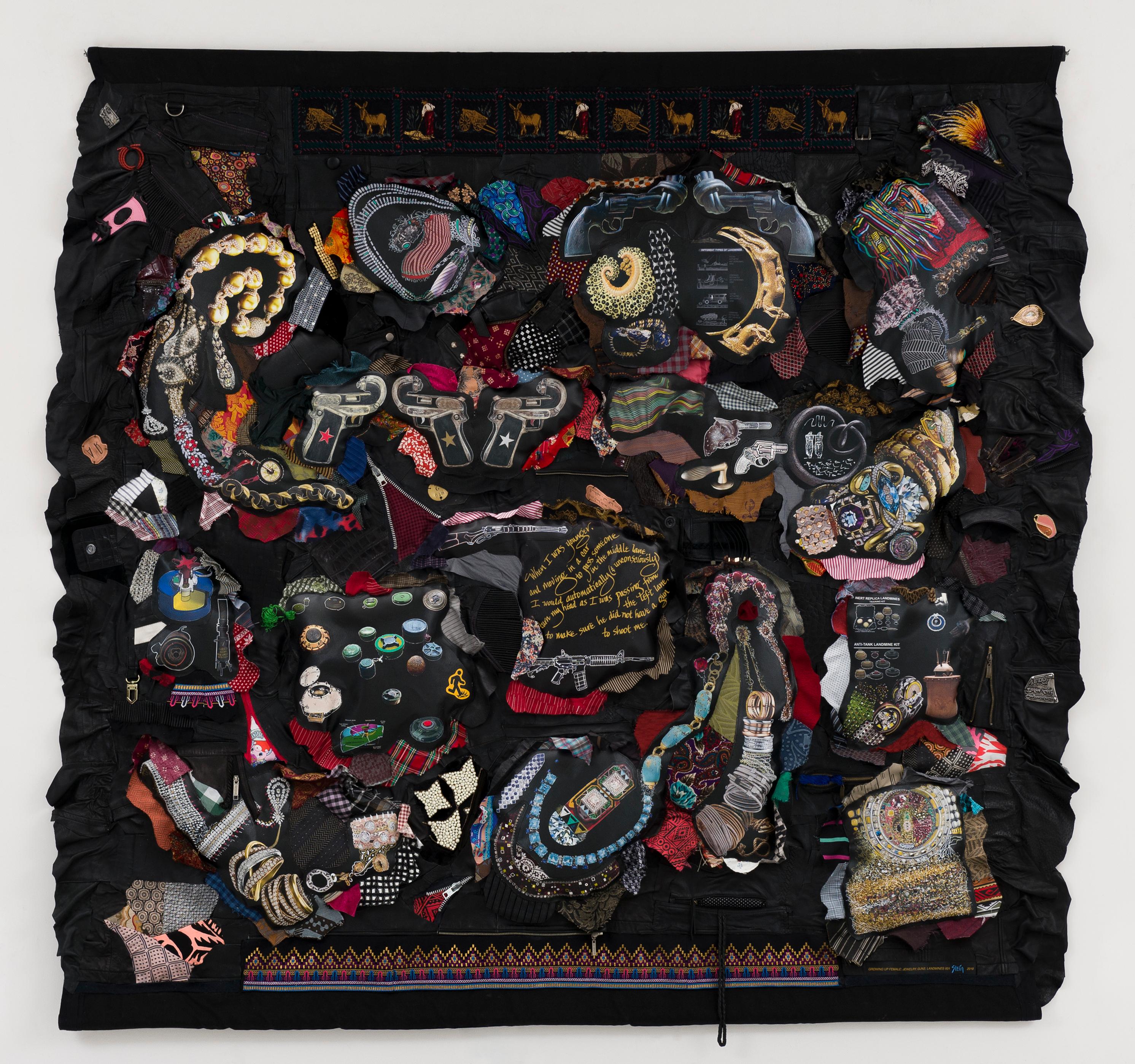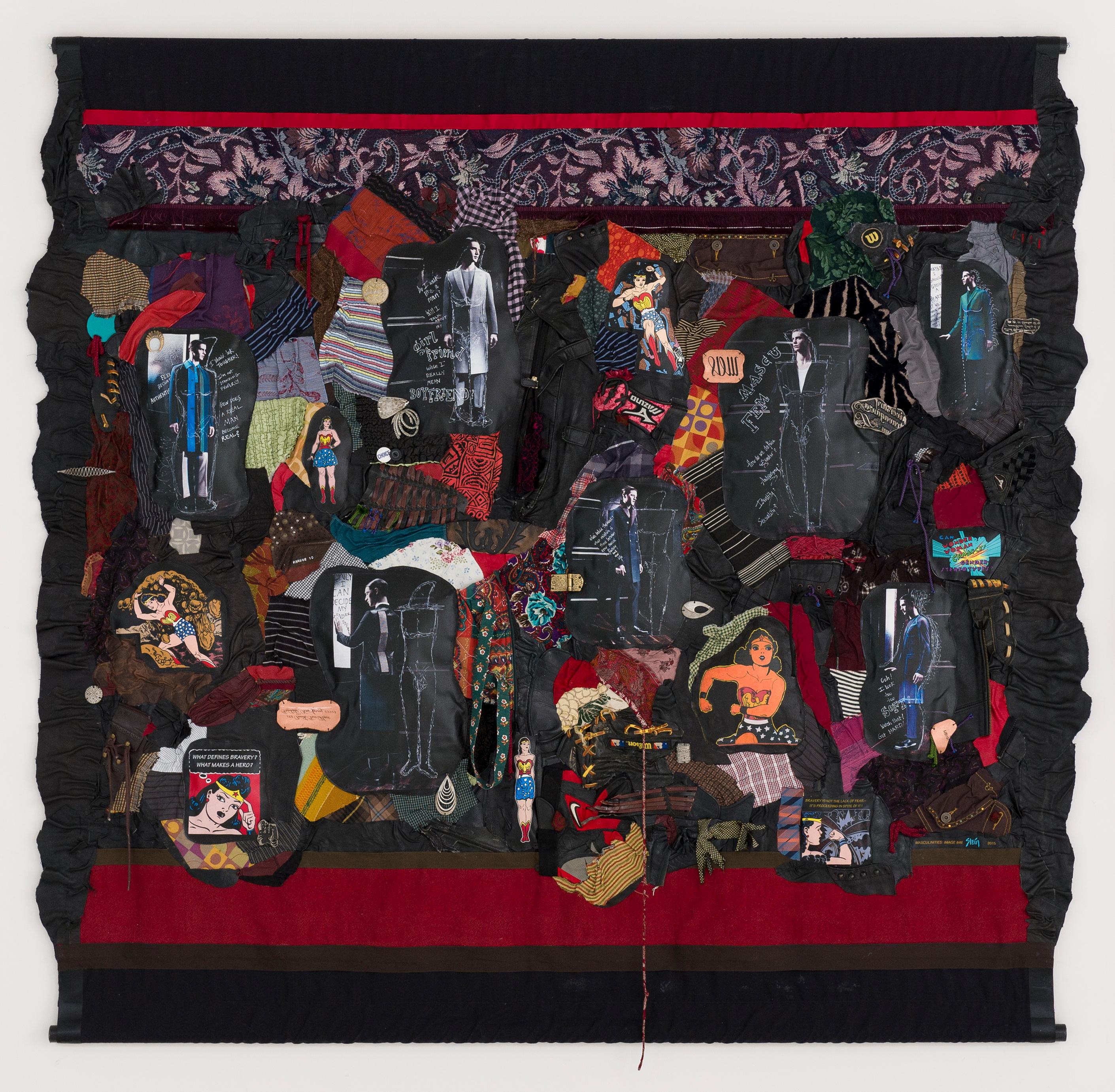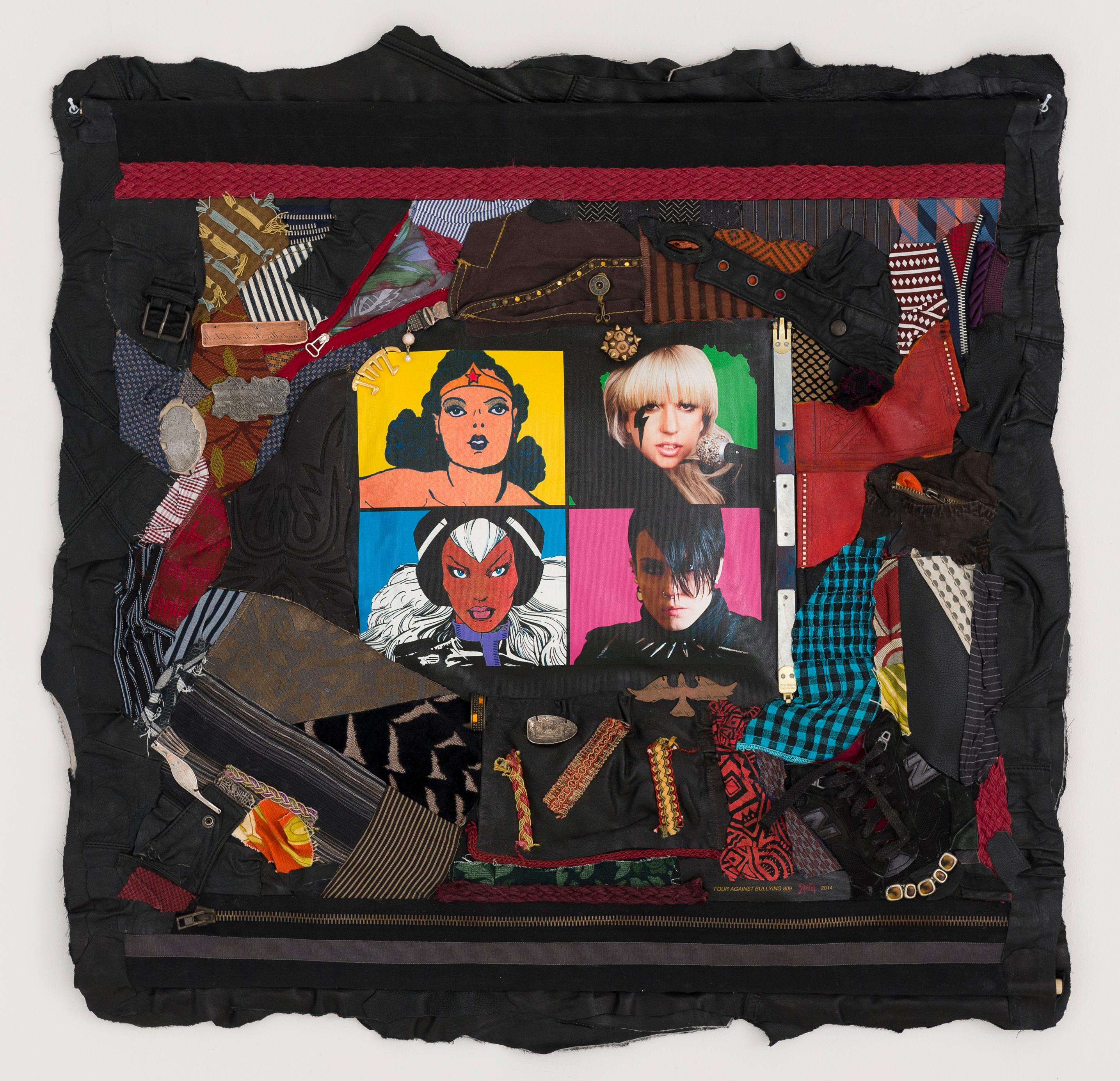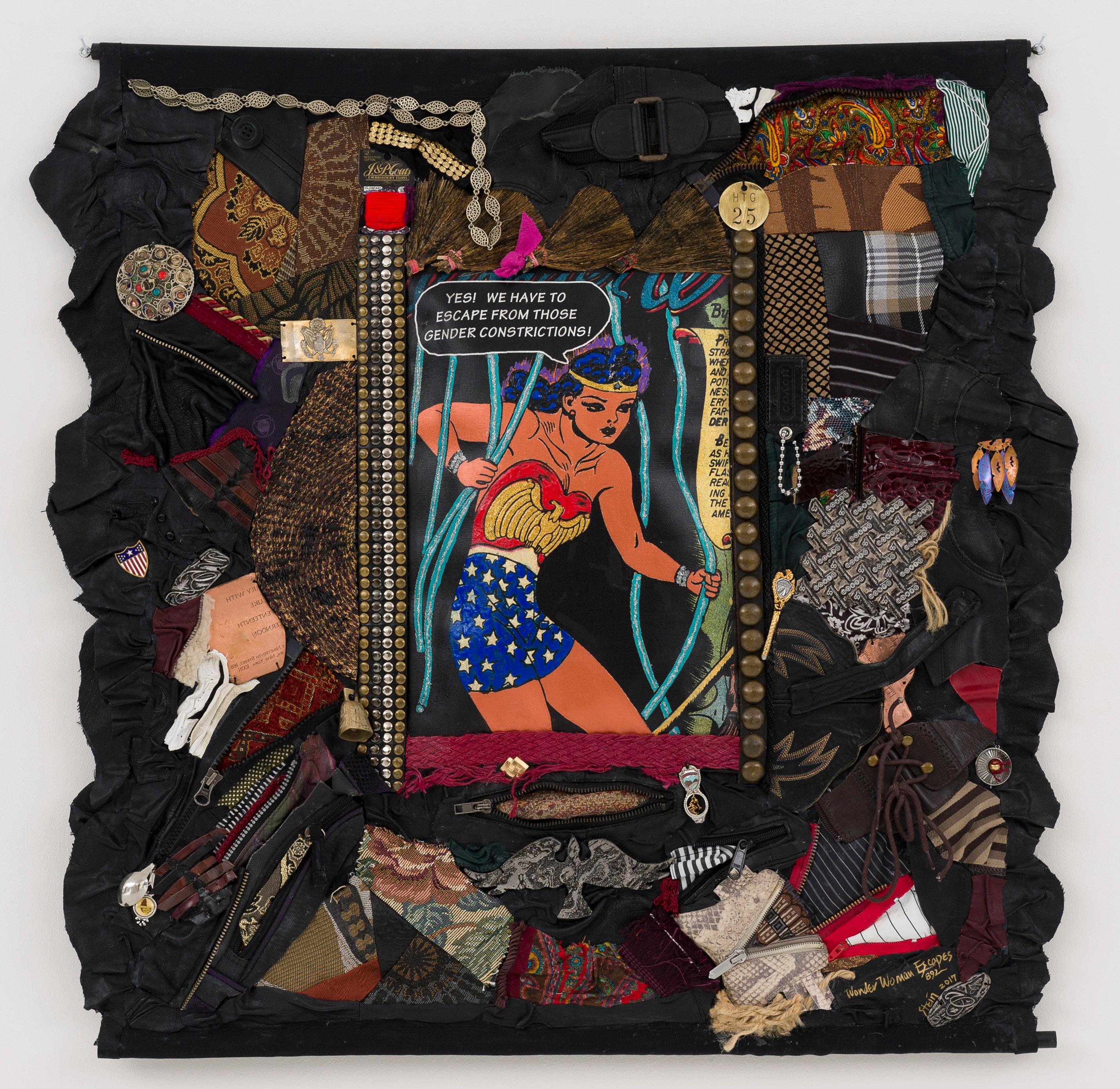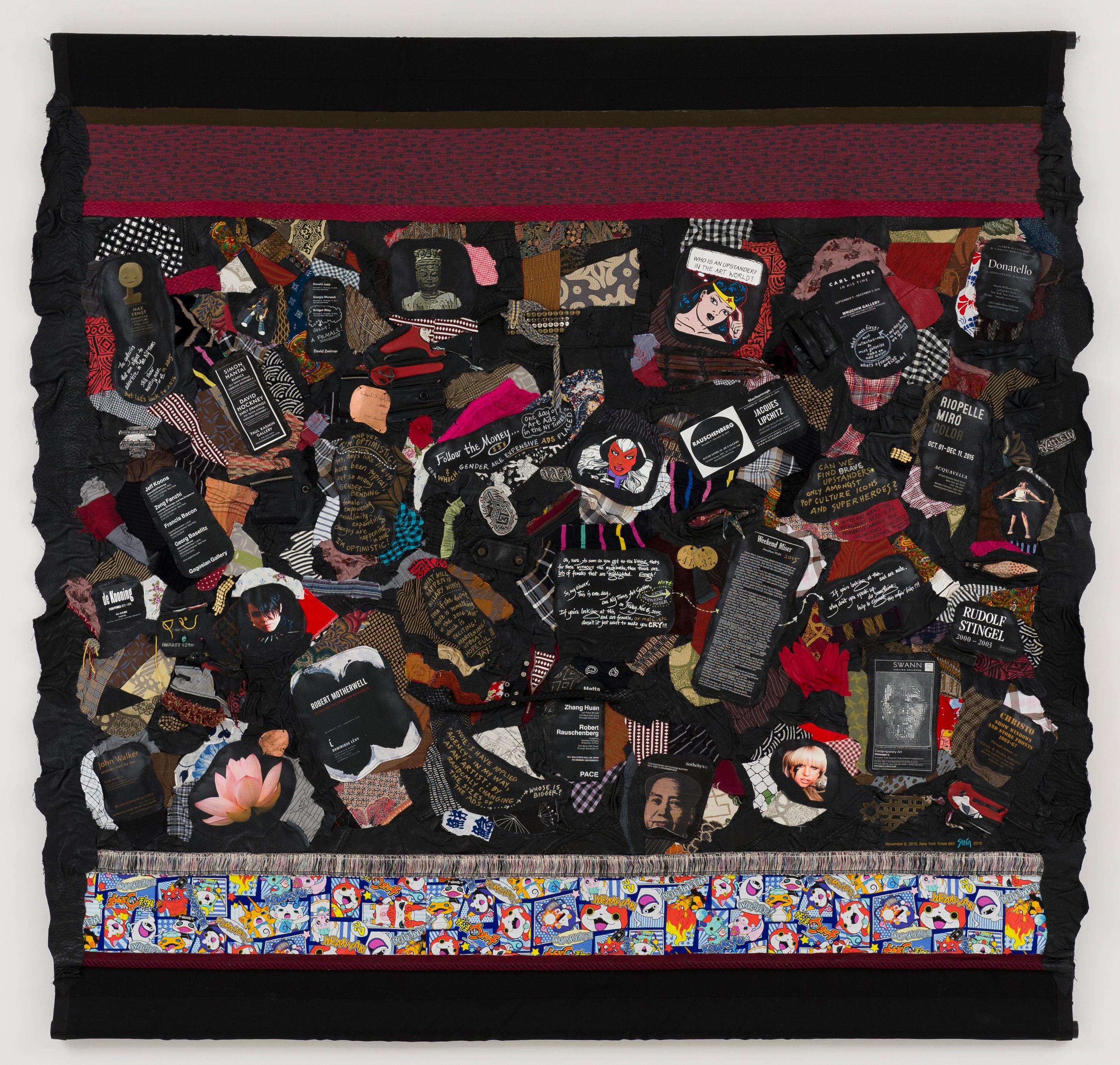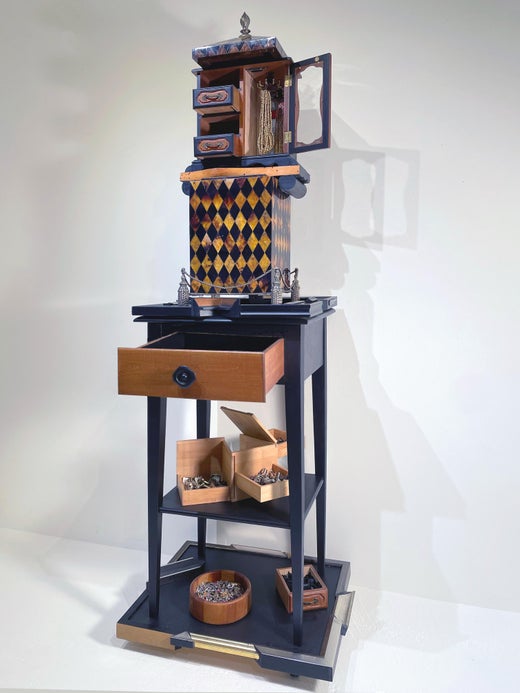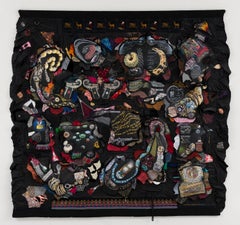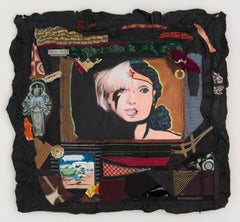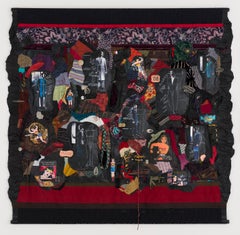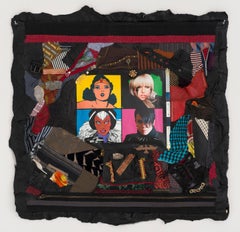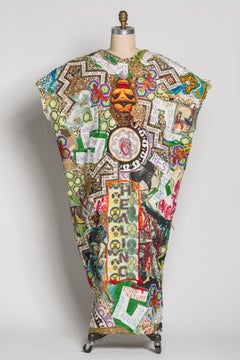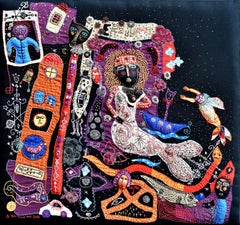Items Similar to Feminist Mixed Media Fabric Leather Black Sculptural Tapestry - Power Merged 804
Want more images or videos?
Request additional images or videos from the seller
1 of 6
Linda SteinFeminist Mixed Media Fabric Leather Black Sculptural Tapestry - Power Merged 8042014
2014
$9,500
£7,231.59
€8,336.22
CA$13,529.16
A$14,755.89
CHF 7,758.05
MX$178,497.67
NOK 96,810.74
SEK 91,476.94
DKK 62,236.14
About the Item
Linda Stein, Power Merged 804 - Feminist Mixed Media Fabric Leather Black Sculptural Tapestry
Stein began to produce sculptural tapestries in 2011, in which she combines images from her pantheon of female Exemplars--Wonder Woman, Princess Mononoke, Storm, Nausicaa, Kannon, and Lady Gaga--with multiple fabrics and leather.
Power Merged 804 was exhibited at Central Michigan University.
Stein's works are in more than 25 museum permanent collections, including Crystal Bridges Museum of American Art, Georgia Museum of Art, and Ringling Museum of Art in the US; Victoria Gallery & Museum and Manchester Art Gallery in the UK; Espoo Museum of Modern Art in Finland; and Konstmuseet i Skövde in Sweden.
- Creator:Linda Stein (1943, American)
- Creation Year:2014
- Dimensions:Height: 36 in (91.44 cm)Width: 34 in (86.36 cm)Depth: 2 in (5.08 cm)
- Medium:
- Movement & Style:
- Period:
- Condition:
- Gallery Location:New York, NY
- Reference Number:1stDibs: LU1818213321891
Throughout her artistic career, Linda Stein's work has addressed issues of persecution and protection, focusing on oppression of the “other” through the lens of anti-bullying and social justice. As result of running for an entire day from the falling Twin Towers in the Ground Zero area of Manhattan, her previously-abstract work after 9/11 became figurative, armor-like, and she realized that she was creating visual and visceral symbols of protection, androgynous sentinel-like figures to stand guard against the foe. Her work often incorporates a family of pop-culture and religious icons like Wonder Woman, Princess Mononoke, Lisbeth Salander, Lady Gaga, Storm and Nausicaa, that start conversations about issues of power and vulnerability. Her works are in more than 25 museum permanent collections, including Crystal Bridges Museum of American Art, Georgia Museum of Art, and Ringling Museum of Art in the US; Victoria Gallery & Museum and Manchester Art Gallery in the UK; Konstmuseet i Skövde in Sweden; and Espoo Museum of Modern Art in Sweden. More can be viewed on her website: https://www.lindastein.com/series
About the Seller
5.0
Vetted Professional Seller
Every seller passes strict standards for authenticity and reliability
Established in 1979
1stDibs seller since 2022
9 sales on 1stDibs
Typical response time: 1 hour
- ShippingRetrieving quote...Shipping from: New York, NY
- Return Policy
Authenticity Guarantee
In the unlikely event there’s an issue with an item’s authenticity, contact us within 1 year for a full refund. DetailsMoney-Back Guarantee
If your item is not as described, is damaged in transit, or does not arrive, contact us within 7 days for a full refund. Details24-Hour Cancellation
You have a 24-hour grace period in which to reconsider your purchase, with no questions asked.Vetted Professional Sellers
Our world-class sellers must adhere to strict standards for service and quality, maintaining the integrity of our listings.Price-Match Guarantee
If you find that a seller listed the same item for a lower price elsewhere, we’ll match it.Trusted Global Delivery
Our best-in-class carrier network provides specialized shipping options worldwide, including custom delivery.More From This Seller
View AllFeminist Contemporary Fabric Leather Sculptural Tapestry - Growing Up Female 931
Located in New York, NY
Linda Stein, Growing Up Female 931 - Feminist Contemporary Fabric Leather Sculptural Tapestry
Growing Up Female: Jewelry, Guns, Landmines 931 is from Linda Stein's Sexism series, w...
Category
2010s Feminist Mixed Media
Materials
Metal
$36,000 Sale Price
20% Off
Feminist Mixed Media Fabric Black Sculptural Tapestry- Brave Spirits Merged 807
Located in New York, NY
Linda Stein, Brave Spirits Merged 807 - Feminist Mixed Media Fabric Black Sculptural Tapestry
Stein began to produce sculptural tapestries in 2011, in which she combines images from...
Category
2010s Feminist Mixed Media
Materials
Metal
Feminist Contemporary Fabric Leather Sculpture Tapestry Masculinities: Image 846
Located in New York, NY
Linda Stein, Masculinities: Image 846 - Feminist Contemporary Fabric Leather Sculpture Tapestry
Masculinities: Image 846 is from Linda Stein's Sexism series, which advocates an exp...
Category
2010s Feminist Mixed Media
Materials
Metal
$36,000 Sale Price
20% Off
Feminist Mixed Media Fabric Black Sculptural Tapestry- Four Against Bullying 809
Located in New York, NY
Linda Stein, Four Against Bullying 809 - Feminist Mixed Media Fabric Black Sculptural Tapestry
Stein began to produce sculptural tapestries in 2011, in which she combines images fro...
Category
2010s Feminist Mixed Media
Materials
Metal
Feminist Mixed Media Fabric Black Sculptural Tapestry - Wonder Woman Escapes 892
Located in New York, NY
Linda Stein, Wonder Woman Escapes 892 - Feminist Mixed Media Fabric Black Sculptural Tapestry
Stein began to produce sculptural tapestries in 2011, in which she combines images from...
Category
2010s Feminist Mixed Media
Materials
Metal
Feminist Contemporary Fabric Leather Sculptural Tapestry - November 6, 2015 865
Located in New York, NY
Linda Stein, November 6, 2015 New York Times 865 - Feminist Contemporary Fabric Leather Sculptural Tapestry
November 6, 2015 New York Times 865 is from Linda Stein's Sexism series,...
Category
2010s Feminist Mixed Media
Materials
Metal
$36,000 Sale Price
20% Off
You May Also Like
Cru si fiction Barbara d'Antuono 21st Century Contemporary outsider textile art
Located in Paris, FR
Embroidered textile painting
Unique work
Penelope or Parque of modern times, Barbara d’Antuono sews by hand like others recite mantras and decides nothing in advance. She lets images arise without any particular coherence with each other, but to which she gives substance in a kind of urgency, in the form of a strip not drawn but sewn. The exhibition, like the eponymous book, covers seven years of this assiduous and patient work through nearly 30 textile works, real freeze frames made of the emotions and memories of the artist, like so many portraits of humanity. . Her meeting in Haiti with Baron...
Category
2010s Contemporary Mixed Media
Materials
Textile
"Self-Portrait" Fabric Assemblage Work
By Jose Canepa
Located in Houston, TX
Abstract Assemblage work with various torn and cut fabrics. The work was donated to the Assistance League of Houston in 2018. Work is signed by the artist on the back and dated. The ...
Category
2010s Assemblage Mixed Media
Materials
Fabric
Textile wearable art: "Priestessing the Work of Healing"
Located in New York, NY
“My contemporary fiber art intersects fashion, sculpture, street art and queer activism through innovative use of textile collage and text-based art techniques. I begin with textiles...
Category
2010s Contemporary Mixed Media
Materials
Textile, Mixed Media
Erzuli, Barbara d' Antuono, 21st Century Contemporary textile art
Located in Paris, FR
Hand sewn textile painting
Unique piece
Signed and dated lower left by the artist
Category
2010s Contemporary More Art
Materials
Textile
Death told her, Barbara d'Antuono, 21st Century Contemporary textile art
Located in Paris, FR
hand sewn textile painting
Unique piece
Signed and dated lower left by the artist
Category
2010s Contemporary More Art
Materials
Textile
Large Mixed Media Collage Painting Great Jewish Feminist Artist Miriam Schapiro
By Miriam Schapiro
Located in Surfside, FL
Miriam Schapiro,
"Curtain Call"
2002
Hand signed, dated and titled verso and signed and dated recto.
acrylic paint, digital images, glitter and textile fabric on canvas, tooling with gold leaf embossing around self edge of painting.
size: 60 x 50 in
Miriam Schapiro (or Mimi Schapiro) (November 15, 1923 – June 20, 2015) was a Canadian-born artist based in America. She was a painter, sculptor and printmaker. She was a pioneer of feminist art. She was also considered a leader of the Pattern and Decoration art movement. Schapiro's artwork blurs the line between fine art and craft. Her paintings contain craft elements because crafts and decoration is associated with women and femininity. She used icons that are associated with women such as hearts, floral decorations, geometric patterns and the color pink. In the 1970s she made a small woman's object, the fan, heroic by painting it six feet by twelve feet. This bears the influence of the Pattern and Decoration movement artists such as Brad Davis, Mary Grigoriadis, Joyce Kozloff, Robert Kushner, Kim MacConnel, Sonya Rapoport, Miriam Schapiro and Valerie Jaudon. Shapiro was born in Toronto, Ontario, Canada. Her father was an industrial design artist who fostered her desire to be an artist and served as her role model and mentor. Her mother was a stay at home mother who worked part-time during the depression.
As a teenager, Schapiro was taught by Victor d’Amico, her first modernist teacher at the Museum of Modern Art. In the evenings she joined WPA classes for adults to study drawing from the nude model. In 1943, Schapiro entered Hunter College in New York City, but eventually transferred to the University of Iowa. At the University of Iowa, Schapiro studied painting with Stuart Edie and James Lechay. She studied printmaking under Mauricio Lasansky and was his personal assistant, which then led her to help form the Iowa Print Group. Lasanky taught his students to use several different printing techniques in their work and to study the masters' work in order to find solutions to technical problems.
At the State University of Iowa she met the artist Paul Brach, whom she married in 1946.. By 1951 they moved to New York City and befriended many of the Abstract expressionist artists of the New York School, including Joan Mitchell, Larry Rivers, Knox Martin and Michael Goldberg.
Schapiro worked in the style of Abstract expressionism during this time period. Shapiro and Brach lived in New York City during the 1950s and 1960s. During this period Shapiro had a successful career as an abstract expressionist painter in the hard-edge style. In December 1957, André Emmerich selected one of her paintings for the opening of his gallery. Schapiro not only honored the craft tradition in women's art, but also paid homage to women artists of the past. In the early 1970s she made paintings and collages which included photo reproductions of Mary Cassatt's and Georgia O'keefe's paintings. Early in her career, Schapiro started looking for maternal symbols to unify her own roles as a woman. Her series, Shrines (1963), was her first artistically successful attempt at compartmentalizing her life roles. Her painting, Big Ox No. 1, from 1968, references Shrines, however no longer compartmentalized. The center O takes on the symbol of the egg which exists as the window into the maternal structure with outstretched limbs. Her series, Shrines was created in 1961–63. It is one of her earliest group of work that was also an autobiography. Each section of the work show an aspect of being a woman artist. They are also symbolic of her body and soul.
In 1964 Schapiro and her husband Paul both worked at the Tamarind Lithography Workshop. One of Schapiro's biggest turning points in her art career was working at the workshop and experimenting with Josef Albers' Color-Aid paper, where she began making several new shrines and created her first collages.
In the 1970s, Schapiro and Brach moved to California so that both could teach in the art department at the University of California. Subsequently, she was able to establish the Feminist Art Program at the California Institute of the Arts, in Valencia with Judy Chicago. The program set out to address the problems in the arts from an institutional position. They wanted the creation of art to be less of a private, introspective adventure and more of a public process through consciousness raising sessions, personal confessions and technical training. She participated in the Womanhouse exhibition in 1972. Schapiro's smaller piece within Womanhouse, called "Dollhouse", was constructed using various scrap pieces to create all the furniture and accessories in the house. Each room signified a particular role a woman plays in society and depicted the conflicts between them. Along with Nancy Spero, Joan Snyder, Joyce Kozloff, Audrey Flack and Judy Chicago, she is from that first generation of Jewish American feminist women artists and includes Judaica in her work.
Schapiro's work from the 1970s onwards consists primarily of collages assembled from fabrics, which she called "femmages". As Schapiro traveled the United States giving lectures, she would ask the women she met for a souvenir. These souvenirs would be used in her collage like paintings. Her 1977-1978 essay Waste Not Want Not: An Inquiry into What Women Saved and Assembled - FEMMAGE (written with Melissa Meyer) describes femmage as the activities of collage, assemblage, découpage and photomontage practised by women using "traditional women's techniques - sewing, piercing, hooking, cutting, appliquéing, cooking and the like..."
She was involved in Abstract expressionism, Minimalism, Computer art, and Feminist art. She worked with collage, printmaking, painting, femmage [fr] – using women's craft in her artwork, and sculpture. Schapiro not only honored the craft tradition in women's art, but also paid homage to women artists of the past. In the early 1970s she made paintings and collages which included photo reproductions of past artists such as Mary Cassatt. In the mid 1980s she painted portraits of Frida Kahlo on top of her old self-portrait paintings. In the 1990s Schapiro began to include women of the Russian Avant Garde in her work. The Russian Avant Garde was an important moment in Modern Art history for Schapiro to reflect on because women were seen as equals.
Schapiro also did collaborative art projects, like her series of etchings Anonymous was a Woman from 1977. She was able to produce the series with a group of nine women studio-art graduates from the University of Oregon. Each print is an impression made from an untransformed doily that was placed in soft ground on a zinc plate, then etched and printed.
Her image is included in the iconic 1972 poster Some Living American Women Artists by Mary Beth Edelson...
Category
Early 2000s Contemporary Mixed Media
Materials
Glitter, Mixed Media, Fabric, Acrylic, Digital
